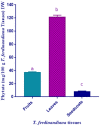Interactions Between Phytochemicals and Minerals in Terminalia ferdinandiana and Implications for Mineral Bioavailability
- PMID: 33425972
- PMCID: PMC7793935
- DOI: 10.3389/fnut.2020.598219
Interactions Between Phytochemicals and Minerals in Terminalia ferdinandiana and Implications for Mineral Bioavailability
Abstract
Oxalic and phytic acid are phytochemicals considered to be anti-nutritional factors as they are predominantly found as oxalates and phytates bound to minerals like calcium and potassium. Studies have associated excessive oxalate consumption with increased urinary excretion of oxalate (hyperoxaluria) and calcium oxalate kidney stone formation, and excessive phytate consumption with decreased bioaccessibility and bioavailability of certain minerals and reduced utilization of dietary protein. However, other studies suggest that dietary consumption of phytate may be beneficial and inhibit formation of calcium oxalate kidney stones. In light of these conflicting reports, dietary intake of oxalate and phytate enriched plants should be considered in relation to potential health outcomes following consumption. Terminalia ferdinandiana is one such plant and is investigated here with respect to oxalate, phytate, and mineral contents. Assessment of oxalate and phytate contents in T. ferdinandiana fruit, leaf, and seedcoat tissues through hydrolysis into acid forms revealed oxalic acid contents ranging from 327 to 1,420 mg/100 g on a dry weight (DW) basis whilst phytic acid contents ranged from 8.44 to 121.72 mg/100 g DW. Calcium content in the different tissues ranged from 131 to 1,343 mg/100 g. There was no correlation between oxalic acid and calcium, however a significant, positive correlation was observed between phytic acid and calcium (r = 0.9917; p < 0.001), indicating that tissues rich in phytic acid also contain higher levels of calcium. The high content of phytic acid in comparison to oxalic acid in T. ferdinandiana fruit found in this study and the dietary significance of this in terms of calcium bioavailability, needs to be investigated further.
Keywords: Kakadu plum; Terminalia ferdinandiana; ascorbic acid; mineral; oxalate; phytate.
Copyright © 2020 Akter, Netzel, Tinggi, Fletcher, Osborne and Sultanbawa.
Conflict of interest statement
The authors declare that the research was conducted in the absence of any commercial or financial relationships that could be construed as a potential conflict of interest.
Figures



 , leaves
, leaves  , seedcoats
, seedcoats  . No significant associations were found except with phytate vs. calcium (pearson r = 0.9917; p < 0.001).
. No significant associations were found except with phytate vs. calcium (pearson r = 0.9917; p < 0.001).Similar articles
-
In vitro Bioaccessibility and Intestinal Absorption of Selected Bioactive Compounds in Terminalia ferdinandiana.Front Nutr. 2022 Jan 27;8:818195. doi: 10.3389/fnut.2021.818195. eCollection 2021. Front Nutr. 2022. PMID: 35155530 Free PMC article.
-
Organic acids in Kakadu plum (Terminalia ferdinandiana): The good (ellagic), the bad (oxalic) and the uncertain (ascorbic).Food Res Int. 2016 Nov;89(Pt 1):237-244. doi: 10.1016/j.foodres.2016.08.004. Epub 2016 Aug 8. Food Res Int. 2016. PMID: 28460910
-
Chemical and Nutritional Composition of Terminalia ferdinandiana (Kakadu Plum) Kernels: A Novel Nutrition Source.Foods. 2018 Apr 12;7(4):60. doi: 10.3390/foods7040060. Foods. 2018. PMID: 29649154 Free PMC article.
-
Dietary treatment of urinary risk factors for renal stone formation. A review of CLU Working Group.Arch Ital Urol Androl. 2015 Jul 7;87(2):105-20. doi: 10.4081/aiua.2015.2.105. Arch Ital Urol Androl. 2015. PMID: 26150027 Review.
-
A review of phytate, iron, zinc, and calcium concentrations in plant-based complementary foods used in low-income countries and implications for bioavailability.Food Nutr Bull. 2010 Jun;31(2 Suppl):S134-46. doi: 10.1177/15648265100312S206. Food Nutr Bull. 2010. PMID: 20715598 Review.
Cited by
-
Unlocking New Approaches to Urolithiasis Management Via Nutraceuticals.Curr Pharm Biotechnol. 2024;25(9):1124-1131. doi: 10.2174/1389201024666230821122416. Curr Pharm Biotechnol. 2024. PMID: 37608670 Review.
-
A Comprehensive Review with Updated Future Perspectives on the Ethnomedicinal and Pharmacological Aspects of Moringa oleifera.Molecules. 2022 Sep 6;27(18):5765. doi: 10.3390/molecules27185765. Molecules. 2022. PMID: 36144493 Free PMC article. Review.
-
Nutritional analysis of rice landraces from southern Odisha, India.Food Sci Nutr. 2023 Oct 13;12(1):227-238. doi: 10.1002/fsn3.3756. eCollection 2024 Jan. Food Sci Nutr. 2023. PMID: 38268889 Free PMC article.
-
In vitro Bioaccessibility and Intestinal Absorption of Selected Bioactive Compounds in Terminalia ferdinandiana.Front Nutr. 2022 Jan 27;8:818195. doi: 10.3389/fnut.2021.818195. eCollection 2021. Front Nutr. 2022. PMID: 35155530 Free PMC article.
References
-
- Chaliha M, Williams D, Edwards D, Pun S, Smyth H, Sultanbawa Y. Bioactive rich extracts from Terminalia ferdinandiana by enzyme-assisted extraction:A simple food safe extraction method. J Med Plant Res. (2017) 11:96–106. 10.5897/JMPR2016.6285 - DOI
LinkOut - more resources
Full Text Sources

